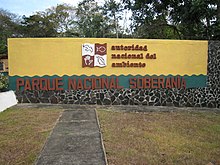Soberanía National Park
| Soberanía National Park | ||
|---|---|---|
|
|
||
| Location: | Panama | |
| Next city: | Panama City | |
| Surface: | 221 km² | |
| Founding: | 1980 | |
The Soberanía National Park is located in the middle of Panama , about 25 km from Panama City , on the eastern side of the Panama Canal and borders the Camino de Cruces National Park in the southern part . Soberanía National Park was established on May 27, 1980.
fauna
About 105 species of mammals, 525 species of birds, 79 species of reptiles, 55 species of amphibians and 36 species of freshwater fish live in the Soberanía National Park.
Here live alongside Jaguar also Jaguarundi , ocelot and gray fox , white-tailed deer , Central American agouti , Paka , raccoon and collared peccary , various species of monkeys such as Geoffroy's tamarin , Panamanian Night Monkey , White-headed Capuchin and mantled howler . Both Central American sloth species Braunkehl- and Hoffmann's two-toed sloth occur as well as Northern Tamandua , winding and Makibär , variegated squirrel , white-nosed coati , nine-banded armadillo , and Northern naked-tailed armadillo , the rare silky anteater and living in hiding Tayra . The world's largest rodent, the Capybara , can also be found near the neighboring city of Gamboa , which reaches its northernmost range here. The South American otter lives in the watercourses .
Pipeline Road
The so-called Pipeline Road (span. Camino del Oleoducto ) is considered by ornithologists to be one of the best areas for observing the tropical birds of America. Around 400 different species of birds have been spotted on this 17.5 km long road alone. Originally this service road, which was formerly paved during the Second World War, was built to maintain an oil pipeline across the entire Isthmus of Panama . However, this was never completed. This is how the road ends today near Lake Gatun . It now consists mostly of gravel. The first four kilometers the road is still relatively wide and level, later it becomes hilly and wetter. In the second half of the canopy is so dense that it is almost closed, and so rare here and shy species of birds prefer undisturbed primary forest, such as gray crown Ameisenvogel , Breitschnabelpipra , river warbler and Tuberkelhokko and the intersecting streams Agami Heron and Sunbittern .
literature
- George R. Angehr, Dodge Engleman, Lorna Engleman: A Bird-Finding Gutide to Panama. Cornell University Press, 2008, ISBN 978-0-8014-7423-1 .
- John F. Eisenberg: Mammals of the Neotropic, The Northern Neotropics. The University of Chicago Press, 1989, ISBN 0-226-19540-6 .
- Fiona A. Reid: Mammals of Central America & Southeast Mexico. 2nd Edition. Oxford University Press, 2009, ISBN 978-0-19-534323-6 .
- Robert S. Ridgely , John A. Gwynne Jr .: Birds of Panama. 2nd Edition. Princeton Paperbacks, 1989, ISBN 0-691-02512-6 .
- Laura and William Riley: Nature's Strongholds. Princeton University Press, 2004, ISBN 0-691-12219-9 .
Web links
- Official website ( Memento of November 5, 2013 in the Internet Archive ) (Spanish)

